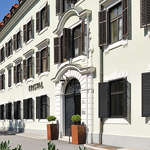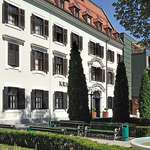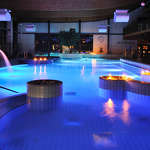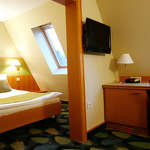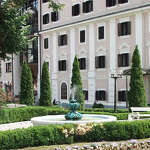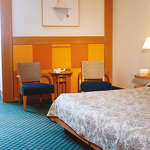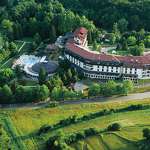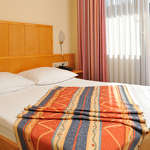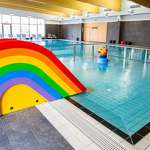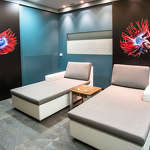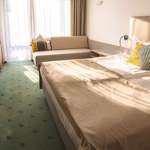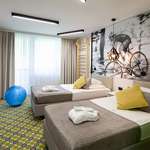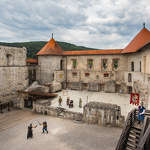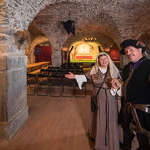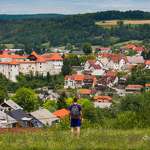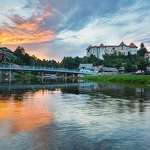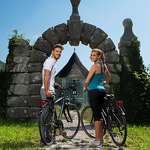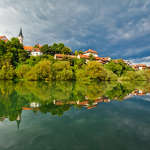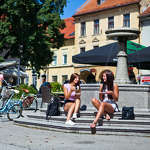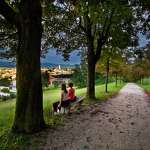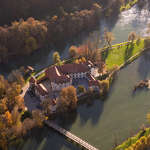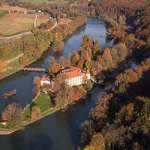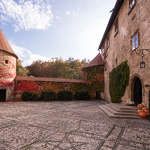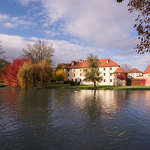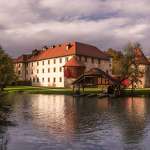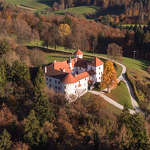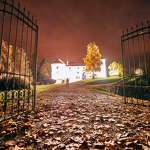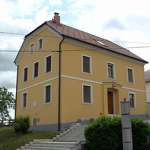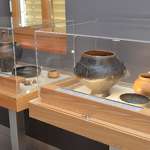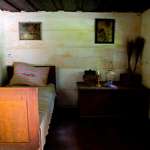
From the Chartusian to the Cistercian Monks
Slovenia is a land of rich history. The country's south-eastern part has always been a way station on numerous trade routes between the north and the south. This heart of a small country situated between vineyard-clad hills and beautiful rivers absorbed the spirituality of the monks from the numerous monasteries. These monks blessed all corners of Slovenia with their produce and products, from the Pleterje Charterhouse Pear Brandy to the natural medicinal herbs of friar Ašič. Experiencing the cultural and ethnological heritage of this part of Slovenia means getting to know the essence of the country. The experience is especially pleasant because it is enhanced by culinary tastings and excellent lunches.
OVERVIEW
DAY 1:
You will begin to discover Slovenian heritage in the part of the country where the people truly strive to understand the life and work of their grandmothers and grandfathers. You will visit two museums showing ancient traditions and depictions of life on homesteads with straw-covered wooden buildings as they were in 1833, and this is where you will feel a genuine connection to the past of Slovenian ancestors and gain a new respect for Slovenian roots and cultural heritage. You will have the opportunity to try the freshly baked Dolenjska pogača flat cake accompanied by the Pleterje Charterhouse wines and brandy as well as learn about the medicinal properties of herbs at the garden of Brother Bernard who will show you the many aspects of folk medicine. You will then take a stroll through the 600 years old monastery tree-lined avenue to the Pleterje Charterhouse where you can appreciate the beauty of the gothic Church of the Holy Trinity from 1406 and the outdoor chapel. The vestry of the gothic church features a multivision presentation of the life of the monks and the history of the Chartusian monks. The products on sale at the monastery shop are renowned the world over so you are certain to take some time out to shop. Before you take your lunch showcasing the local delicacies, you will stop at one of the gems of Slovenian architecture, the Otočec Castle. After lunch, you can take a walk through the old town that has had the name Novo mesto since 1365. After sightseeing, you will dine at the hotel and enjoy your well-earned rest.
DAY 2:
After breakfast, you will drive northward along the Krka River. Along the way, you will first stop at the Devil's Tower, the clover-shaped baroque tower surrounded by stone walls with three stone portals. It was once a part of the estate of the former mighty castle owned by the last princes of Auersperg who used to escape from reality and into mysticism. You will stop for coffee or tea at the pleasant little town of Žužemberk boasting a once mighty castle that rises above the Krka River. A few kilometres onwards you will find the oldest and still active Cistercian monastery in Slovenia, the Stična Abbey. The monastery was made famous around the world by friar Ašič with his natural medicinal products. The monastery houses the Slovene Museum of Christianity that you will have the opportunity to admire. This will be followed by lunch. You will treat your taste buds to both homemade and modern culinary dishes of Slovenia. You will then drive to Bogenšperk Castle in the afternoon from the walls of which the famous Janez Vajkard Valvasor admired the amazing landscape in the 17th century. The museum installations and exhibits will present you with the history of the castle, its owners as well as the life and work of the famed Carniola polymath and member of the English Royal Society, Janez Vajkard Valvasor (Johann Weichard Freiherr von Valvasor).
PACKAGE PRICE PER PERSON
- VIP package with a guide and transportation: from 298 €
- Group trip: from 239 €
THE ADVENTURE/PACKAGE INCLUDES
- Visit to the House of Living Heritage
- Visit to the Pleterje museum
- Visit to the Charterhouse of Pleterje
- Sightseeing in Novo mesto
- Visit to the Stična Abbey
- Visit to the Bogenšperk Castle
- 2 x lunch in the selected restaurant
- 1 x dinner
- 1 x overnight stay with breakfast at the hotel ****
For more information about trips and activities click here.
ADDITIONAL INFORMATION
- Program can be carried out from 1 May to 31 October, arrivals possible every day of the week
- the program is intended for groups of 2–7 persons and larger groups for which the program can be adapted
- Possible to combine two or more packages
- Tourist fee is included in the price
- Due to the Covid-19 situation, VIP tours and group tours are suspended until further notice.
Hotel Kristal ****

Hotel Kristal is located in the town of Dolenjske Toplice. It is connected to Hotel Balnea ****, and a panoramic hallway also connects it to the Balnea Wellness Centre.
The Dolenjska region abounds in picturesque landscapes with meadows, vast deciduous forests, murmuring green streams and rivers, and plentiful vineyards that make it synonymous with relaxation and calmness. The hotel is an excellent starting point for excursions. A hike through a primeval forest is a great experience you should not miss out on, and the Otočec Adventure Park is a must if you're travelling with children.
All those craving sports on their holidays can exercise at the hotel. The hotel offers fitness facilities as well as group exercises to strengthen the cardiovascular system and improve stamina. They like to boast of being the first in Slovenia to merge wellness with the modern findings of classic medicine. They have developed a medico wellness centre with a varied programme, the Balnea Wellness Centre with three spectacular features: the Lagoon with indoor and outdoor swimming polls and a whirlpool, the Oasis with a sauna centre and the Aura facility offering reflexology, various massages and other relaxation methods… Special feature: terrace for nudists.
The hotel with a 100 year long tradition offers 55 comfortable and air conditioned rooms with an LCD TV, mini bar and free WiFi. They offer suites and apartments for those who require more space.
The restaurant with a self-service breakfast and menu-based lunch or dinner is going to delight you because it is a well-known fact that Dolenjska is a land of good food and the homemade Cviček wine. They also organise themed evenings, and dishes for guests with special dietary needs are also available by special order.
Hotel Vital ****

Hotel Vital is located in the green surroundings near the Krka River in the town of Dolenjske Toplice. Thermal springs and magnificent landscape have long attracted guests wishing to improve their health and forget about everyday problems.
The hotel has a rich history going back to 1776. It is a haven for those who love and enjoy nature and an active lifestyle. The primeval forest of Kočevski pragozd, Trška gora mountain, Kostanjevica na Krki, Otočec with the mediaeval castle … thematic trails, wonderful vineyards with vineyard cottages and to finish things off, the very special wine Cviček.
When the time comes to relax, you can dive into three swimming polls with thermal water heated to 36 °C (97 °F). The annex is home to the recognised Medicinal Rehabilitation Centre as well as a gym, a fitness centre, a cosmetic salon and a solarium. Next to the beautifully landscaped park you will find the Balnea Wellness Centre that is spread out over 9200 m². The rich relaxation offer comprises indoor and outdoor swimming pools, saunas, baths, whirlpools, facial and body care, body sculpting, massages and much more.
There are 105 rooms equipped with a satellite TV, mini bar and hairdryer. The lobby has an Internet corner.
The self-service restaurant offers authentic dishes of the Dolenjska region.
Hotel Šmarjeta ****
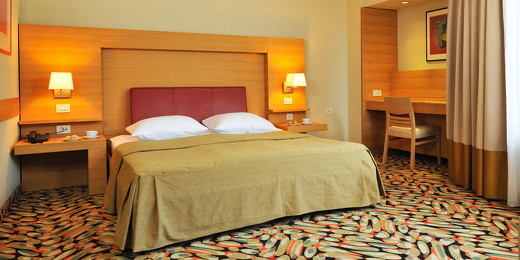
Hotel Šmarjeta is nestled in the magnificent landscape of the town of Šmarješke Toplice, embraced by forests and green plains.
The surrounding paths and local roads are excellent for cycling as well as Nordic skiing and skiking (Nordic rollerblading) as there are numerous marked hiking trails around. An active holiday must of course offer pampering which is offered here in the form of thermal relaxation programmes.
Indoor swimming pools at the Vitarium Aqua Centre located on hotel grounds will be your haven of soft music that relaxes the body and soul and energizes you for new challenges ahead. We must not forget the wooden pool right under a thermal spring. The sauna world offers exfoliation treatments, wraps, massages and relaxing baths. Take a peek into the Vitarium Spa&Clinique wellness centre offering life improvement services subject to a surcharge.
The hotel has 99 air conditioned rooms that are spacious and well-appointed. Rooms are equipped with a satellite TV, mini bar and free WiFi.
The self-service restaurant prepares meals using exclusively produce from ecological production as they know the importance of healthy food for a healthy life. The breakfast is self-service, while lunch and dinner feature 4 main dish menus with self-service entrees, soups, desserts and salads.
Hotel Toplice ***
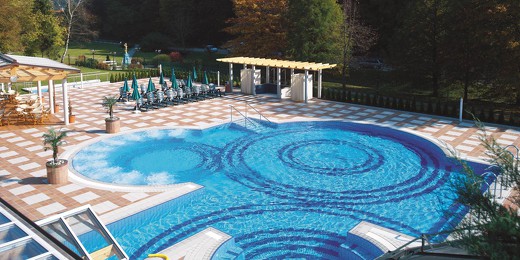
Hotel Toplice is nestled in the town of Šmarješke Toplice, the south-eastern part of Slovenia embraced by forests and meadows.
If you like spending time in complete peace and quiet, while at the same time enjoying comfort, then the Toplice Hotel is the right choice for you. You can be active and discover a myriad paths as there are numerous marked trails for Nordic walking thanks to the town of Šmarješke Toplice developing the first Nordic walking centre in Slovenia. You can get on a bike and cycle to the nearby vineyards as well as see other attractions such the Otočec Castle with its flagship attraction, the golf course.
You will do wonders for your wellbeing at the Vitarium Aqua thermal park comprising two indoor and three outdoor swimming pools as well as saunas. The team of experts will help you care for your health with detox therapies that will return balance to your body. Medico wellness will provide you with improved quality of life that is certain to make you return here time and again.
The hotel has 47 small and beautifully appointed rooms with a queen-size bed (w=160 cm), hairdryer, satellite TV, mini bar and safe.
The self-service restaurant prepares delicious dishes using exclusively produce from ecological production as they know the importance of healthy food for a healthy life. Dishes for guests with special dietary needs are available by special order.
Hotel Šport ****
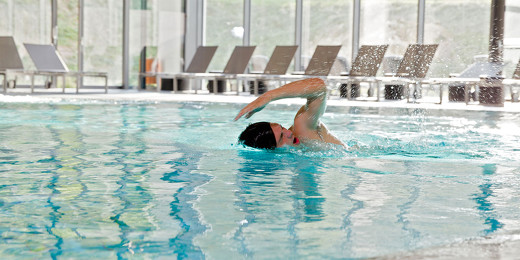
Welcome to the Šport Hotel that boasts the title of the hikers'/cyclists' hotel as it is an outstanding vantage point for activities in nature. Novo mesto is approximately 7 km away.
Otočec, which is considered the crown jewel of Dolenjska, has a rich offer of sporting activities. It is famous for its top-level golf courses, and is a popular destination for cycling, skiking, and tennis… You can enjoy in the untouched nature and walks through the nearby forests where the clean air will clear you lungs. You can enquire about excursions to nearby vineyard cottages hiding amongst the vineyard strewn hills and offering homemade food and wine.
After an exciting day, treat yourself to some relaxation at the indoor pool or sauna and sooth your body and soul. You can also visit the nearby spa of Šmarješke Toplice offering thermal water with healing properties.
There are 80 rooms equipped with a satellite TV, mini bar and hairdryer. Free WiFi is also available. Exercise in specially equipped facilities offers many benefits as you can stretch out your spine or improve your physical abilities using a punching bag, wall bars, exercise bands …
The hotel restaurant serves local specialties and offers a rich selection of wines. The meals are self-service. Those who enjoy a romantic ambiance will enjoy the service at the Grajska restavracija restaurant.
House of Living Heritage
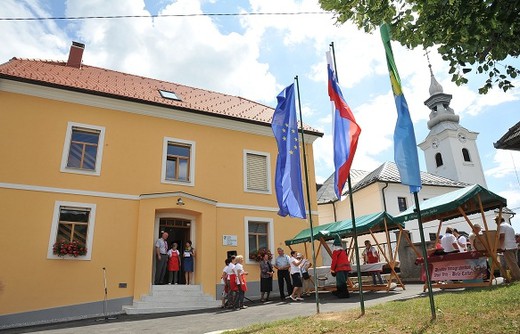
The House of Living Heritage is located at the spot where the old Bela Cerkev primary school used to stand. The House operates an intergenerational heritage interpretation centre under the slogan "From Nature and Past for the Future", that aims to highlight the importance of natural and cultural heritage of the area in to share it with the next generation in the most innovative way while at the same time presenting the rich heritage of Šmarješke Toplice.
The central character or symbol of the House is the orant (Praying Man), a pendant from Celtic times representing a male figure that goes beyond the boundaries of a circle which symbolises the fact that we must free ourselves of our shackles, open ourselves to the world, create new content and projects while simultaneously giving meaning to our rich heritage.
Upon entering the House of Living Heritage, you can first view a presentation film about the Municipality of Šmarješke Toplice at Zwitter hall which bears the name of historian Fran Zwitter born in Bela Cerkev.
Since our winegrowers understand the significance of producing good grapes and good-quality wine, the House of the Living Heritage provides them with a state-of-the-art oenological laboratory for carrying out measurements as well as organizing wine-tasting events.
You can get acquainted with the local cuisine in the Room of Living Heritage where you will also get a chance to participate in various workshops, bread baking, potica making, etc.
In the Room of Creativity you can take part in creative oenological workshops or see restored old school exhibits and a temporary exhibition.
You will be transported into the past in the Land of Archaeology room. Here you can take a stroll through different historic periods such as prehistory, antiquity and the migration period. You can also learn more about the lives of local inhabitants from the 8th century BC onwards through the displayed replicas found in the wider area of Vinji vrh.
In the Room of Our Ancestors you can get acquainted with the work of influential figures who were born in these parts or lived and worked here (Fran Zwitter, Jože Karlovšek, Janez Zalokar, etc.). The room is intended for lectures, training seminars, workshops, exhibitions, music lessons, activities of cultural societies...
Children can spend some time in the Dwarf's Room, where they will hear about the legend of Vini, the dwarf from Bela Cerkev, and other local folk tales.
Pleterje Open Air Museum
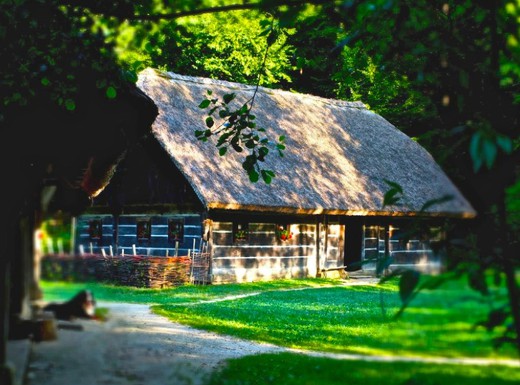
The museum is a true gem in its presentation of the exhibits of folk architecture in the Dolenjska region. The design came about as a result of cultural/protection and other needs to preserve wooden buildings with thatched roofs from the 19th century whereby design cues were taken from the first such museum in the world in Stockholm, Sweden.
The revival of ancient traditions and the depiction of life on a homestead made up of wooden buildings with a thatched roof, like those in 1833, presents the genuine past of Slovenian ancestors to both domestic and foreign visitors and instils in them a new respect for Slovenian roots and cultural heritage. The open air museum is suitably arranged for various types of visitors ranging from educational institutions and tourist to business partners of domestic and foreign companies and organisations as well as for the organisation of various pre-agreed events that comply with monastic rules. The design of the Pleterje Open Air Museum is rich and complemented by other activities making for a more interesting visit and offering options such as buildings and spaces for various activities (seminars, meetings, lectures, courses, workshops, training events, presentations of old crafts, customs, habits and chores as well as the option of participation in open air events and festivals). These kinds of museum take the visitor to an entirely different world of the past – the world of forgotten values and traditions, homemade food, simple clothing and modest way of life under difficult circumstances.
Pleterje Charterhouse
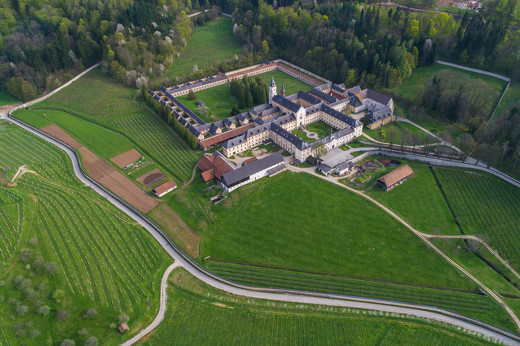
Did you know that Carthusian monks live in an enclosure? This means that they are completely removed from the world and that they only rarely admit people to their charterhouse. If you are a woman, you will never enter. Nonetheless, a walk around the walls of this charterhouse that was founded in 1403 is a special experience. You can take a look at the interior of the Gothic church, and if you are lucky, you will be able to hear monks singing Gregorian chants in Latin. Make sure to buy their pear brandy (“liquid pear”) to take home with you.
Otočec Castle

Romance and fairy-tales are words that come to mind when you see a wooden bridge, the broad expanse of the blue River Krka bustling with swans and ducks, mighty trees, and an island surmounted by a Gothic and Renaissance building. Otočec Castle is the only island castle in Slovenia, and is surrounded by a 200-year old park filled with indigenous and exotic tree species. There are also a golf course and a health resort nearby. The castle houses a world-class restaurant and a luxurious hotel, a member of the Relais & Châteaux chain.
Don’t miss out on the picturesque landscape surrounding Otočec Castle, the only castle situated on a rivet islet in Slovenia. The magnificent castle park was most likely formed at the turn of the 18th into the 19th century. It displays numerous autochthonous tree species, such as black alder, white willow, black poplar, as well as some examples of exotic tree species. The Krka River is home to 32 different fish species – including many rare and endangered species. Huchen, Wels and Danube Roach are the most highly valued species in angling. The white Mute Swans are special feature of Otočec. The first pair was introduced here in 1968. The present population now numbers over 50 individuals.
Novo mesto
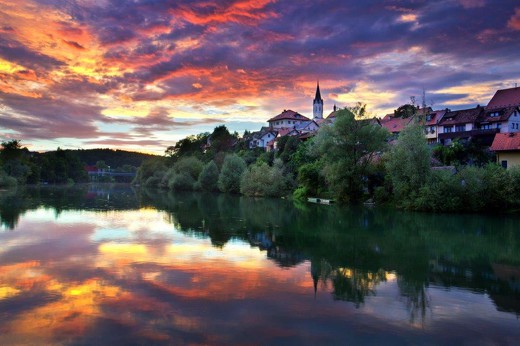
Novo mesto is the centre of the Dolenjska region with archaeological heritage of global importance. The city of the Situla pottery is surrounded by vineyard strewn hills producing the characteristic Cviček wine and by the mysterious Gorjanci mountain range. The outstandingly rich archaeological finds in the area of Novo mesto point to the several thousand years long settlement of the current urban area of Novo mesto. The city was established on 7 April 1365 by the ambitious Habsburg Duke Rudolf IV. During the turbulent times of Turkish incursions and up to the end of the 18th century, the city was surrounded by walls. There were only two entrances to the city, the northern one named Gorenja or Ljubljanska vrata gate, and the southern named Dolenja or Karlovška vrata gate. The latter stood at the location where the Pugljeva ulica street ends today. The famed Breg rose on the remnants of a part of the city walls at the end of the 18th century, which is one of the loveliest motifs of the city to paint. The vista of the city centre has for centuries been most vividly characterised by the bell tower of the Church of St. Nicholas and Church of St. Leonard which is part of a Franciscan monastery. The central part of the old town centre is represented by the beautiful square of Glavni trg. The most recognisable architectural motif of the square is the arcade hallways in the upper part of the square. The town hall building stands out on the Glavni trg square, which is the seat of the city's management and was built at the start of the 20th century.
Devil's tower
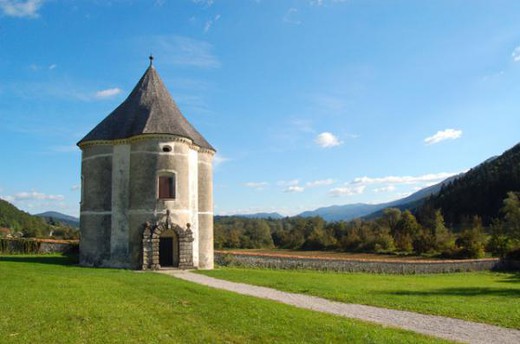
The most interesting jewels of Slovenia's landscape are very often those that are shrouded in a veil of mystery. One such place is the Devil's Tower in Soteska, a little village between two forested plateaux. The tower has stood here for over three hundred years, a place of entertainment and sinful pleasure. A place whose history is linked to the princes of Auersperg who had a great manor house in Soteska and, not far away, a garden pavilion: a Baroque tower with a trefoil ground plan, surrounded by a stone wall pierced by three stone portals, a place in which to escape from reality and into mysticism. The Devil's Tower is divided into two storeys connected by a spiral stone staircase. The entire interior of the building is richly decorated with trompe l'oeil compositions. On the ground floor the motif is of fountains and portals, while the vaulting shows a mythological scene of Zeus abducting Ganymede. Upstairs are trompe l'oeil scenes of porticoes and female figures personifying faith, hope and love. The paintings were excuted by the workshop of the Dutch master artist Almanach.
The building, which has excellent acoustics, is today used as a venue for concerts and art exhibitions, leading visitors into the universe of medieval or modern music and art.
Žužemberk

Žužemberk Castle is one of the most picturesque and typical mediaeval castles in Slovenia. Its mighty remains rise over the steep rocks above the Krka River. The year 1000 is supposedly engraved above the rectangular tower which leads us to believe that the castle was built by Viljem I, husband of St. Ema and administrator of the Savinjska krajina region. The count of Gorica, Albert II, bought the castle in 1295 from nobleman Heinzelin Marainwetz. After the extinction of the Gorica counts in 1374, the members of the Habsburg family became the new owners of the castle, and the castle was also leased for a while by the counts of Celje. In 1538 the brothers Jurij and Wolf Auersperg from Turjak bought the castle. The most famous owner of the castle was definitely Prince Johann Weikhard of Auersperg, the tutor of Emperor Ferdinand III, court councillor and the first minister in the Habsburg monarchy, who obtained the right of primogeniture, so that the castle was not for sale and could pass from generation to generation. There are many stories that are connected to the castle and most are tragic. The first is from 1559 when Gregor, the illegitimate son of Jurij Turjaški, seized the castle on Candlemas and market day. The occupation did not last long as Herbart Turjaški was nearby and defeated the attackers. The failed attackers met with a horrible fate as they were thrown over the city walls and the bodies were taken to the forest. In 1575, a domesticated bear killed Ana von Eck, wife of Ivan Turjaški, in the courtyard. To commemorate the tragic event, they planted a birch tree that grew until 1999. The castle housed terrible dungeons and later various bureaus and the local court that was relocated in 1893. The castle began to fall into ruin which lasted until WWII when allied bombing struck the last nail in the castle's coffin in February 1945. In the 1960s, renovations of the castle began and gained a new impetus in 1996 with the establishment of a castle renovation committee. In the summer time, Summer Castle Games are organised in the courtyard and former wine cellar of the castle and in the square in front of the castle. The games have been organised at the castle since 1997 by the Turistično društvo Suha krajina tourist association. The biggest crowds are attracted by the Trški dnevi (Square Days) events featuring a mediaeval day all of which are organised as part of the celebration of the municipal holiday on 15 July.
Stična Abbey
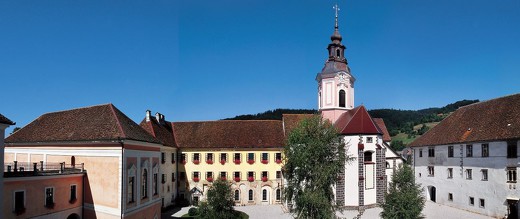
The oldest and still working Cistercian monastery in Slovenia was established in 1132. Visitors today can amaze at the architectural cues of the Romanesque, Gothic and Baroque periods. Some of the attractions here include the cloister (cross-shaped hallway), abbey church and Museum of Christianity. Cistercians are known for the production of products made of medicinal herbs and for using clay for medicinal purposes. They will advise you on what is good for your health.
Its beginnings date back to 1132, in the Romanesque period. The monastery soon became the religious, ecclesiastical, cultural and economic centre of Carniola. Before the reforms introduced by Emperor Joseph II, the monastery’s library kept the valuable illuminated Stična manuscripts in Latin, dating from the 12th and 13th centuries. In 1428 an important manuscript for Slovenian linguistics was written at Stična, one of the first texts in the Slovenian language.
The monastery complex changed its appearance over the centuries. The oldest part of the monastery remains preserved in the cloister and abbey church.
In 1784 the monastery was abolished following the Josephine reforms. The White Monks returned to Stična in 1898 after 114 years away. They continue their centuries-old tradition in the Cistercian spirit of Ora et Labora. The Stična Abbey remains one of the oldest spiritual and cultural centres in Slovenia.
Bogenšperk Castle
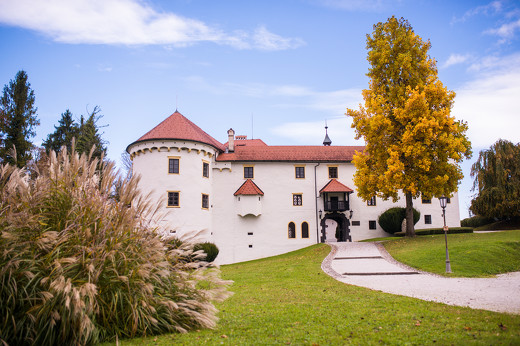
Built in the early 16th century as the successor to a medieval fortress, this castle was designed in the shape of a square with four towers and a large internal courtyard. Its owners frequently changed, but its heyday was during the period of the famous Janez Vajkard Valvasor (Johann Weikhard von Valvasor) (1672–1692), who was a polymath and a member of the British Royal Society. His impressive body of work, which includes a study of the intermittent Lake Cerknica and a history of most of the area that is today's Slovenia, can be seen at the castle.
Bogenšperk castle can be considered a Renaissance building with four towers (according to oral tradition, they were built first and then connected to one another), where the northern one is less prominent than the rest. The family of Wagen, who even had the right of coinage during their reign, owned the castle until the first half of the 17th century. Jurij, the last member of the family, left the castle to Augustinian monks, with whom he lived as a tertiary until his death in 1630. However, the mentioned Catholic order did not possess the castle. Because of Jurij’s debts, the castle’s ownership was put into the hands of the main creditor, pharmacist and then mayor of Ljubljana, Horacij. But apparently the latter soon sold it to Krištof Kočevar who owned Bogenšperk only for a short period of time. The castle was then bought by nobleman Jurij Kheysell and later in 1672 by Johann Weikhard von Valvasor. After Valvasor's bankruptcy in 1692, the castle became the property of Janez Andrej Gandin. In the fire caused by lightning in April 1759, the castle sustained extensive damage. Then owner Aleksander Anton Höfern managed Bogenšperk poorly and despite the help of States in its renovation, the castle and its estate again changed the owner in 1774: they were taken over by Höfern's biggest creditor, Mihael Skube from Ribnica, who sold it to the family of Wogathey (Bogataj) only 18 years later. Nevertheless, the passing of the castle from hand to hand was not yet over. Ignac Bogataj, the son of Janez Štefan who bought the building, sold the castle together with its land in 1853 to Duke Weriand von Windischgrätz, who started buying property in Carniola and Lower Styria around that time. Beside Bogenšperk, he also became the owner of Hošperk, Konjice, Podsreda and Predjama castle. The family also set itself to partly renovate the building and the traces of their work are still visible in the library today.
In the 20th century, a special chapter began in Bogenšperk's history; a series of interesting events followed one after another, especially in the period after the First World War. One of the most attention-grabbing events was definitely when Prince Paul of Yugoslavia, the main personality of the Royal governorship after the assassination of King Alexander in October 1934 in Marseille, expressed his interest in buying the castle and its estate as his summer residence.
The Second World War did not just temporarily divide Slovenia, but also denoted a turning point for Bogenšperk. In April 1941, the castle served as a border crossing between Germany and Italy, the occupying forces that divided most of the Slovenian territory amongst themselves. The border was later moved, but the division was fateful for these lands. During Italy's capitulation in September 1943, the Windischgrätz family left Bogenšperk and took its most precious valuables. After the departure of the German army at the end of the war in 1945 and after serving as a military hospital, the castle came to its lowest point, for it was plundered of everything. In such bad conditions, it became home to Jesuit monks that were banished from the monastery of Saint Joseph in Ljubljana. Jesuits moved into Bogenšperk in 1949 and managed the castle and its surrounding for the next 15 years. In 1964 new owners from the Trbovlje Investment Bureau were planning to turn the castle into a luxurious hotel, but failed to do so. Therefore, after 1970 began the systematic renovation of the building, which was taken over by the Municipality of Litija who appointed a committee for this purpose. The renovation gave rise to various activities. The castle initially offered the organisation of weddings, then hospitality services and later even opened a museum.
- H1 Hotel Kristal ****
- H2 Hotel Vital ****
- H3 Hotel Šmarjeta ****
- H4 Hotel Toplice ***
- H5 Hotel Šport ****
- 6 House of Living Heritage
- 7 Pleterje Open Air Museum
- 8 Pleterje Charterhouse
- 9 Otočec Castle
- 10 Novo mesto
- 11 Devil's tower
- 12 Žužemberk
- 13 Stična Abbey
- 14 Bogenšperk Castle
-
- VIP tour with tourist guide and transportation
- Group trip
-
No. of peopleConfirm
Transfer from the airport
Guests arriving by air will be offered comfortable transfers at competitive prices from close by airports. Our chauffeur will meet you at the arrival and will bring you back safely and on time
to the airport at the departure. You can cancel the transfer from your home to the hotel without expenses within 72 hours prior to scheduled transfer. You will receive the information about the exact time of departure a day before the scheduled transfer.
-
From - to:
-
Distance:km
-
Travel time:h
-
Type of transfer:One-way transfer
-
Price:€ per person
-
Number of people:
-
From - to:
-
Distance:km
-
Travel time:h
-
Type of transfer:Return transfer
-
Price:€ per person
-
Number of people:
Transfer from home to the hotel
Guests from northern Italy are offered the possibility of transport from home to the hotel. You can choose between
morning or afternoon directory term, the carriage is available for 2-7 passengers, reservation up to 5 days prior to departure. The notice of the exact time and location of departure one day prior to the tour.
-
From - to:BENETKE - MORAVSKE TOPLICE
-
Distance:km
-
Travel time:h
-
Type of transfer:One-way transfer
-
Price:€ per person
-
Number of people:
-
From - to:BENETKE - MORAVSKE TOPLICE
-
Distance:550 km
-
Travel time:5,5h
-
Type of transfer:Return transfer
-
Price:€ per person
-
Number of people:
Holidays in Slovenia portal.
You will receive an automatic reservation recapitulation on your e-mail address,
final confirmation will be sent upon payment.
You will receive an update on your reservation within 2 hours; if not, please, call us as soon as possible or send e-mail. Also check SPAM.
Thank you for your confidence and best regards.
HolidaysinSlovenia.eu

